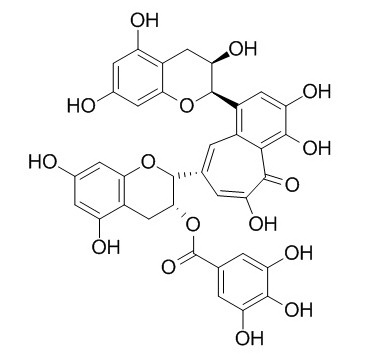Theaflavin-3'-gallate
Theaflavin-3'-gallate, acts as prooxidants and induces oxidative stress, with carcinoma cells more sensitive than normal fibroblasts.
Inquire / Order:
manager@chemfaces.com
Technical Inquiries:
service@chemfaces.com
Tel:
+86-27-84237783
Fax:
+86-27-84254680
Address:
1 Building, No. 83, CheCheng Rd., Wuhan Economic and Technological Development Zone, Wuhan, Hubei 430056, PRC
Providing storage is as stated on the product vial and the vial is kept tightly sealed, the product can be stored for up to
24 months(2-8C).
Wherever possible, you should prepare and use solutions on the same day. However, if you need to make up stock solutions in advance, we recommend that you store the solution as aliquots in tightly sealed vials at -20C. Generally, these will be useable for up to two weeks. Before use, and prior to opening the vial we recommend that you allow your product to equilibrate to room temperature for at least 1 hour.
Need more advice on solubility, usage and handling? Please email to: service@chemfaces.com
The packaging of the product may have turned upside down during transportation, resulting in the natural compounds adhering to the neck or cap of the vial. take the vial out of its packaging and gently shake to let the compounds fall to the bottom of the vial. for liquid products, centrifuge at 200-500 RPM to gather the liquid at the bottom of the vial. try to avoid loss or contamination during handling.
Vietnam J. Chemistry2022, 60(2):211-222
Academic J of Second Military Medical University2018, 39(11)
Chung Shan Medical University2020, US20200323790A1
Food Science and Biotechnology2022, 10.1007.
Processes2021, 9(1), 153.
Current Topics in Nutraceutical Research2021, 19(1),p90-105.
Int J Mol Sci.2021, 22(10):5181.
Mol Med Rep.2022, 26(4):299.
LWT2024, 200:116184.
J Pharm Biomed Anal.2024, 241:115990.
Related and Featured Products
Basic Clin Pharmacol Toxicol. 2008 Jul;103(1):66-74.
Theaflavin-3-gallate and theaflavin-3'-gallate, polyphenols in black tea with prooxidant properties.[Pubmed:
18346048]
This study compared the in vitro responses of human gingival fibroblasts and of carcinoma cells derived from the tongue to theaflavin-3-gallate (TF-2A) and Theaflavin-3'-gallate (TF-2B), polyphenols in black tea.
METHODS AND RESULTS:
In a cell-free assay, TF-2A and Theaflavin-3'-gallate reacted directly with reduced glutathione (GSH), in a time- and concentration-dependent manner. Intracellular storages of GSH were depleted on treatment of the cells with the theaflavin monomers. Depletion of intracellular GSH was more extensive with TF-2A than with Theaflavin-3'-gallate and was more pronounced in the carcinoma, than in the normal, cells. The toxicities of the theaflavins were potentiated when the cells were cotreated with the GSH depleter, d,l-buthionine-[S,R]-sulfoximine. In the presence of catalase, pyruvate and divalent cobalt, all scavengers of reactive oxygen species, the cytotoxicities of the theaflavins were lessened. TF-2A and Theaflavin-3'-gallate induced lipid peroxidation in the carcinoma cells, whereas in the fibroblasts, peroxidation was evident upon exposure to TF-2A, but not to Theaflavin-3'-gallate.
CONCLUSIONS:
These studies demonstrated that the black tea theaflavin monomers, TF-2A and Theaflavin-3'-gallate, act as prooxidants and induce oxidative stress, with carcinoma cells more sensitive than normal fibroblasts.



